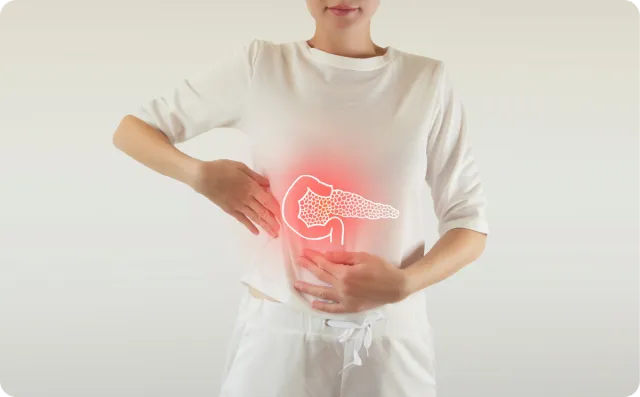
Jump to
Book a visit
$25 typical copay
$100 without insurance
Get constipation relief today from the comfort of your own home.
A virtual constipation treatment consultation makes it easy to talk to a doctor about your symptoms and get a personalized treatment plan, fast and discreetly.
Key takeaways:
- Occasional changes in poop color are normal, but some colors may signal a health issue.
- Many factors, like diet, can affect stool color, but persistent or unusual colors may need attention.
- Knowing when to consult a doctor is essential for staying on top of your health.
Let’s face it—everyone wonders about their poop color now and then. While it may seem strange to pay close attention, stool color can give insights into your digestive health.
What’s normal? When should you be concerned? From the common brown to the surprising blue, this guide covers what each color could mean and when it’s best to check in with a doctor.
What the color of your poop can indicate
Poop color can be affected by various factors, including diet, hydration, and overall digestive health. The natural color of stool typically ranges from shades of brown to green, largely because of bile—a yellow-green digestive fluid made in the liver. As bile moves through your intestines, it turns brown due to interactions with enzymes and bacteria.
However, there are cases where other colors may appear, and while many of these are harmless, some might indicate a need for further attention. Let’s dive into what each color might mean for you.
Colors of poop and what they mean
Your poop color can change from time to time, and often, it's nothing to worry about. These changes can result from what you've eaten, recent medications, or other lifestyle factors. However, some colors may hint at underlying health issues.
Brown
Brown is the most common and generally healthy color for poop. This color results from a combination of bile from the liver and bacteria in the gut breaking down food. It usually means that digestion is working well and the body is processing nutrients as it should.
If your stool is consistently brown, it’s typically a good sign that everything is normal. However, a very dark brown, almost black stool can be worth watching, as it may suggest something minor like dehydration or too much iron in your diet. But as long as it stays mostly brown, you’re likely in good shape.
Black
Black stool can be alarming, but sometimes it has a simple explanation, like eating foods rich in dark pigments (such as black licorice or blueberries) or taking iron supplements.
However, if black stool is persistent with no dietary explanation, sticky, or tar-like, it might indicate bleeding in the upper digestive tract, like the stomach. Bleeding here can turn the stool dark because blood darkens as it moves through the intestines. If you notice black stool without a clear dietary reason, and especially if you have stomach pain or other symptoms, you should check in with a doctor.
Gray
Gray or clay-colored stool may indicate a potential issue with bile production or flow, which is necessary for breaking down fats and giving stool its typical brown hue.
Causes can range from gallbladder problems to liver issues or blockages in the bile ducts. If gray stool appears once, it may be due to a temporary issue, but recurring gray or pale stool could suggest a more serious health concern. If this is the case, consult a healthcare provider, as problems with bile can impact digestion and nutrient absorption over time.
Blue
Blue stool is rare but can sometimes appear after consuming foods or drinks with strong blue coloring, like certain candies or drinks. Some people may also experience blue stool after consuming medications or supplements with blue dye.
If blue stool appears without a clear dietary cause, it could signal an issue with dye or chemical exposure. While it’s usually harmless, unexplained blue stool might be worth discussing with a healthcare provider if it continues.
Green
Green stool often happens when food moves through the intestines too quickly, like during a bout of diarrhea. In these cases, bile doesn’t have time to break down fully, leaving a greenish hue.
Eating many green leafy vegetables or foods with green dye can also cause this color. If green stool appears with other symptoms like stomach cramps, it might indicate a mild infection or something affecting digestion speed. Generally, green stool resolves on its own, but if it becomes persistent or you’re concerned, a quick check-in with your doctor can provide peace of mind.
Yellow
Yellow or greasy-looking stool can sometimes indicate poor fat absorption, possibly due to a condition affecting the pancreas or small intestine. Yellow stool can also result from a diet high in fatty foods.
However, when combined with a strong odor, it may suggest a condition like celiac disease, where the body struggles to absorb nutrients from certain foods. If yellow stool occurs frequently or you notice other symptoms, consulting with a doctor can help ensure there’s no underlying issue affecting nutrient absorption.
Orange
Orange stool is most commonly caused by a diet high in beta-carotene, the pigment found in orange foods like carrots and sweet potatoes. This type of stool is typically harmless and will resolve as your diet varies.
In rare cases, orange stool can indicate a bile issue, especially if it persists without dietary reasons. If the orange color continues or you notice digestive discomfort, a healthcare provider can help rule out any bile-related problems.
Red
Foods with strong red pigments, such as beets, tomatoes, or red food coloring can sometimes cause red stool.
However, bright red stool may also indicate bleeding in the lower digestive tract, such as the rectum or colon. This could be due to hemorrhoids or more serious issues like colorectal polyps or ulcers. If you’re unsure about the cause, especially if red stool continues or appears with discomfort, you should seek medical attention.
White
White or pale stool may indicate an issue with bile flow, similar to gray stool. Certain medications, like antacids, can also make stool pale.
However, white stool should be noted, as it often suggests something affecting the liver, gallbladder, or bile ducts. If you see white stool, it’s worth discussing with a healthcare provider to ensure no serious blockage or liver issue is preventing normal digestion.
Read our guides on different types of stool and healthy vs. unhealthy stool for more.
When to see a doctor about the color of your poop
If you notice a sudden or unexplained change in stool color, you should closely monitor the changes. In many cases, the color of stool can vary due to diet, hydration, or temporary issues, but sometimes it indicates a more serious health concern.
You should see a doctor if:
- A color change persists for more than a few days, especially without dietary explanation.
- There is a small amount of blood in the stool.
- You experience other symptoms such as nausea, stomach pain, or unintentional weight loss alongside the color change.
You should go to the emergency room if:
- You notice significant amounts of blood or if the stool is dark and/or tar-like.
- Abdominal pain is intense, persistent, or worsening, especially with unusual stool color.
- You’re experiencing severe dehydration, dizziness, rapid heartbeat, or other symptoms of dehydration, along with changes in stool color.
Questions to ask a doctor about the color of your poop
If someone was going to seek medical care for this symptom - what are 3-4 important questions to ask their provider so they can get the best care?
- Could my diet, medications, or supplements be causing this change in color?
- Are there any specific tests you recommend to better understand what might be causing this?
- Are there lifestyle changes or dietary adjustments that could help prevent unusual stool colors?
- Is this color linked to any underlying condition that needs regular monitoring?
Frequently asked questions: color of poop meanings and causes
People often have questions about what stool color might mean for their health. Here are answers to some of the most common ones:
What is an unhealthy stool color?
Generally, colors like black, white, or bright red in the stool are considered “unhealthy” and may indicate internal issues such as bleeding or bile flow problems. While one-time changes are often harmless, monitor these colors and consult a healthcare provider if they persist.
What color is your stool if you have liver problems?
Stool that’s pale, white, or gray can sometimes indicate liver or bile duct issues. Bile gives stool its brown color, so a lack of bile may point to a liver-related problem. If you notice pale stool consistently, consult a healthcare provider.
What color is your stool if you have colon problems?
Bright red or dark, tarry stool can sometimes indicate bleeding in the colon or rectum. This can be due to hemorrhoids, but if you’re also experiencing other symptoms or this is new, it’s important to see a doctor to rule out more serious colon conditions.
Understanding bowel movement health
Stool color can offer important clues about your health, especially when paired with other symptoms. Occasional changes in color are often harmless and linked to diet or minor digestive fluctuations.
However, persistent color changes or those paired with discomfort should be checked out by a healthcare provider to ensure everything is functioning properly. Staying aware and keeping a balanced diet can help you maintain a healthy digestive system and feel your best.
General Medicine follows a strict editorial process, including using real experts to write our articles, vetted primary sources, fact-checking, a secondary medical review, and updates as necessary. This article was medically reviewed and fact checked by Dr. Pallabi Sanyal-Dey, MD.
Sources
Ohno H, Murakami H, Tanisawa K, Konishi K, Miyachi M. Validity of an observational assessment tool for multifaceted evaluation of faecal condition. Sci Rep. 2019 Mar 6;9(1):3760. doi: 10.1038/s41598-019-40178-5. PMID: 30842504; PMCID: PMC6403287.https://pmc.ncbi.nlm.nih.gov/articles/PMC6403287/pdf/41598_2019_Article_40178.pdf
Wilson ID. Hematemesis, Melena, and Hematochezia. In: Walker HK, Hall WD, Hurst JW, editors. Clinical Methods: The History, Physical, and Laboratory Examinations. 3rd edition. Boston: Butterworths; 1990. Chapter 85. Available from: https://www.ncbi.nlm.nih.gov/books/NBK411/
Walker TJ. On the Clinical Significance of Colourless or Clay-coloured Stools unaccompanied by Jaundice, and their connection with Disease of the Pancreas; and on the part played by the Pancreas in Eliminating Bile from the Intestines. Med Chir Trans. 1889;72:257-73. doi: 10.1177/095952878907200115. PMID: 20896747; PMCID: PMC2121540. https://pmc.ncbi.nlm.nih.gov/articles/PMC2121540/
Azer SA, Sankararaman S. Steatorrhea. 2023 May 16. In: StatPearls [Internet]. Treasure Island (FL): StatPearls Publishing; 2024 Jan–. PMID: 31082099. https://www.ncbi.nlm.nih.gov/books/NBK541055/
Mehanna D, Platell C. Investigating chronic, bright red, rectal bleeding. ANZ J Surg. 2001 Dec;71(12):720-2. doi: 10.1046/j.1445-1433.2001.02277.x. PMID: 11906386. https://pubmed.ncbi.nlm.nih.gov/11906386/
Our editorial standards
At General Medicine, we cut through the clutter to make health care clearer, faster, and easier to navigate. Every article is grounded in evidence-based research and peer-reviewed journals, reviewed by medical professionals, and written in accessible language that helps you make health decisions with confidence. We’re committed to ensuring the quality and trustworthiness of our content and editorial process by providing information that is up-to-date, accurate, and actually useful. For more details on our editorial process, see here.



